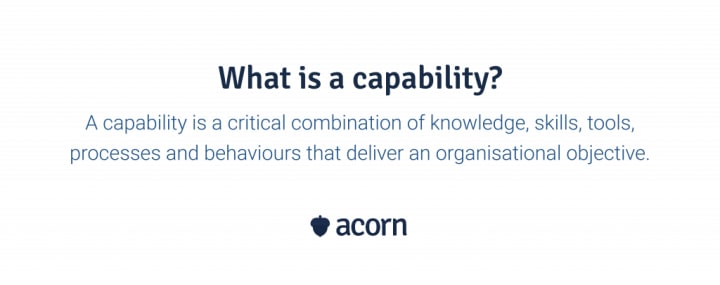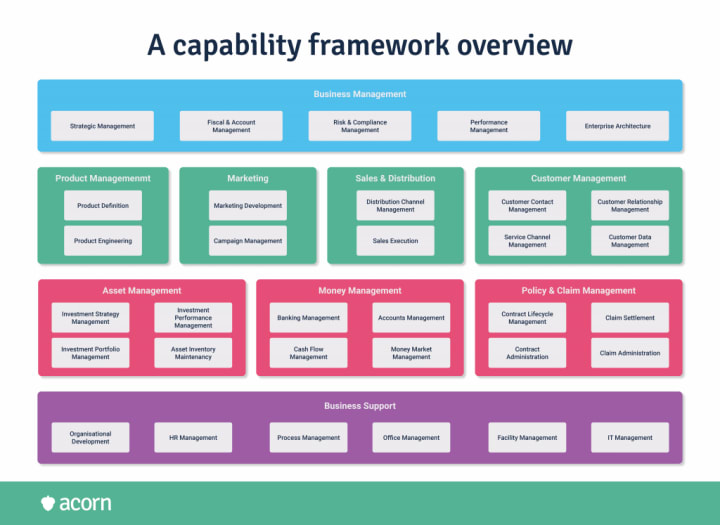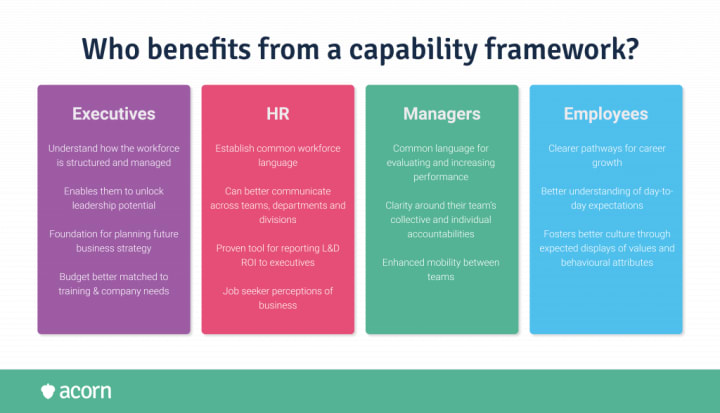
This article first appeared on Acorn Labs in November 2021.
Upskilling, reskilling or invoking practices aimed at making your organisation sustainable are best done with some backing. It’s called a capability framework, and it’s a key part of achieving growth targets and strategic priorities.
A capability framework outlines the skills, knowledge and behaviours needed for employees to achieve business goals, essentially linking business objectives with personal performance. It’s the nexus of all your workforce planning activities. Think: Role design, performance management, recruitment, and professional development. And most crucially, it’s what defines your ability to grow and succeed.
Let’s dive into everything you need to know about capability frameworks, from the structure and how to utilise it in the workplace all the way to getting a better ROI on your L&D efforts.
What is a capability framework?
A capability framework outlines the skills, behaviours and knowledge required for an organisation’s personnel to achieve business goals. Capabilities are usually mapped to job roles and job families to define capabilities that are fundamentally important for an employee to be successful in their role. In this way, capability frameworks can be used to recruit, manage performance and create internal mobility.

Why are capability frameworks important to human resources?
Firstly, let’s define what “capability” means.
A capability is a mix of knowledge, skills, tools, processes and behaviours that combine to deliver an organisational objective.
Capabilities, though organised into levels of proficiency based on job roles and their corresponding business responsibilities, are considered critical at any level to achieving business success. In other terms, capabilities define what a business does in order to fulfil its mission.
A capability framework describes those capabilities, and associated expectations of proficiency, in a way all employees can understand. For example: the NSW Public Sector Capability Framework lists Manage Self as a capability. Across several grades of proficiency, this is described as:
- Prioritising one’s task load
- Evaluating your own performance & seeking feedback
- Seeking development opportunities
- Managing emotions
- Taking initiative
- Utilising negative feedback for growth
- Acting as a role model for colleagues
- Promoting the value of self-improvement
- Keeping up to date with current practices.
Your capabilities will and should change as your company grows and your goals evolve. The roles needed in a tech start-up will be more niche than a global software company. And the roles that tech start-up needs when they’re past their growth stage will be vastly different and more varied than the first time they ever recruit.
And then there’s the employee experience to consider. How can they truly be sure they’re effectively performing their roles, embodying business values, and working well with others? Are they certain of the skills and knowledge needed to progress in their careers? How can team leaders accurately measure and manage performance?
So, just why is a capability framework so important to organisational success?
By defining the skills, knowledge and behaviours needed for effective performance at all levels in your company, you create a universal language that’s accessible for everyone in the business. A capability framework also crucially establishes how each role relates to organisational outcomes.
Clear expectations for both success and the personnel life cycle is what drives proper workforce planning (WFP). It also enables your HR team to effectively align their work with strategic business goals, as well as more clearly communicate across departments.
The 12 key benefits of a capability framework
- Implementing a capability framework enables your organisation to:
- Recruit talent more effectively through job and role design
- Maintain an adequate talent supply now and into the future
- Better evaluate performance and manage talent
- Identify and close skills gaps more efficiently
- Provide more personalised professional development
- Improve the quality of services or products and customer or client relations
- Act on strategic succession and workforce plans
- See clear progression from level to level
- Enact change management processes
- Stay clear on how to successfully complete daily tasks
- Understand and unlock leadership potential
- Create career pathways across teams and departments.
So, yeah, not exactly small change.
The structure of workforce capability frameworks
A capability framework has a few defining features:
- It balances technical and soft skills
- It defines ascending proficiency levels
- It’s entirely unique to your organisation.
Skills can often be portable across organisations (cough, transferable skills, cough), but capabilities and capability frameworks are always contextually unique to your company. They’re not tied to one team or process, either. Your capabilities, and capability framework, are cross-functional. It can be tempting to look at a framework and search for “your part”, because schematics can look very much like an organisational hierarchy.
Remember: Capabilities are defined in business terms. Each defines what it does for the business. If you would change a capability to “suit” different departments or every time you implement a new system involved in delivery on that capability, it’s not a capability.
A capability framework shows capabilities by levels of proficiency. Proficiencies correlate to a standard of performance expected at a certain level of employment (i.e., entry level all the way through to C-Suite). Think of it as a scale or spectrum. It isn’t a matter of being capable or not capable, or possessing or not possessing a skill, but rather progressively increasing capacity and competency.

At the most meta level, you’ll have a select suite of focus capabilities which incorporate complementary capabilities. Some organisations may also choose to create occupation-specific capabilities, particularly for roles that require specialist technical or professional knowledge.
What are focus capabilities?
Focus or core capabilities are the main groupings of capabilities within a framework. These are the highest level of knowledge, skills and attributes employees must possess to effectively perform their roles, and are intrinsic to your company not only thriving, but existing.
Think of them as your main food groups. You need a balanced variety of vegetables, fruits, grains, dairy and protein to survive. No one group is more important than the other, nor would you suggest that any of your friends only focus on a single group for optimal health. Rather, each bring offers its own value to your personal goals.
Examples of focus capabilities include:
- Results / outcomes
- People management
- Personal attributes
- Standardisation
- Strategy
- Leadership
- Relationships
These are all broader drivers of business success, and in practice, often encompass business know-how and technical and interpersonal skills. Unilever lists Product Management as a focus capability because it is core to their business. This is part of what Unilever does. McDonald’s has Community as one, which aligns with their charitable contributions like Ronald McDonald House. These examples are both unique to the companies’ abilities and services, and part of their competitive advantage.
So, essentially, if you can identify what your business can do better than anyone else, then you should codify that.
Focus capabilities don’t need to be segmented by departments or job families. Think of them as reinforcing activities. If you want more information, a good example comes from NSW Government. Their Public Sector Capability Framework has three core capability groups that apply to all job roles and two that are applicable only managers, for a total of five focus capabilities. Focus capabilities are generally meant to be viewed contextually together to gain a more comprehensive picture of what is expected for employees.

How can you apply a workforce capability framework?
Let’s look to the public sector for some examples. The NSW Government use theirs for everything from writing job descriptions to promoting mobility. ASIO’s (that’s the Australian Security Intelligence Organisation) outlines what is needed to deliver against their purpose (access by clicking here). The National Disability Insurance Scheme says their capability framework provides a common language to describe “what good looks like” (access here) for those who use their services.
Basically, if you want to provide great services to your client base, future proof your business success, and create an internal talent supply, you’ll need a workforce capability framework.
Don’t be fooled into thinking it’s just a public sector tool. A sustainable and successful business, company or agency needs a plan that accounts for best- and worst-case scenarios—which is where frameworks come in. Reducing and possibly preventing business risk is a core element of capability frameworks.
And while these frameworks may feel suited to large enterprises, smaller organisations without a human resources team can hugely benefit from one. Lacking dedicated HR roles can mean functions like staffing, employee development, management and growth can be hard to optimise. What unites all the earlier examples is that anyone can access them. A framework can act as a guide for all employees to understand their roles, managers to use during recruitment, and a map for expansion and growth.

How managers can use capability frameworks
Capabilities may seem like a C-Suite or HR practice—but a framework is an incredibly useful tool for managers in their day-to-day. Managing a team’s performance is an intricate and often time-consuming process. It can help benefit and streamline:
- Writing job descriptions
- Recruitment and development
- Performance management
- Strategic WFP.
Job role descriptions
The art of writing job descriptions is one few can master. It’s the first tone-setter for potential recruits, so it’s important not to misstate the knowledge, skills and abilities required for a role. It’s also often a point of reference for managing performance evaluations. Enter: Your capability framework.
If you have occupation-specific capability sets, managers are able to note the foundational capabilities expected for a certain role without much fanfare. Even without capabilities mapped to specific roles, job descriptions can easily be created from your framework.
For example: The following focus capabilities can be filtered down by complementary capabilities, represented as responsibilities in a job description for an executive assistant.
- Personal Attributes > Self-management
- Results > Prioritise tasks by outcome
- Relationships > Effective communication
- Standardisation > Handle internal documentation.
Recruitment
Career and professional development opportunities are incredibly powerful recruitment tools. In a post-pandemic world, employees are more than willing to move jobs that offer career advancement. Frameworks can be used by managers in interviews as a demonstration of potential career growth, and even made publicly available as part of a brand toolkit and employee value proposition. Internally, when aligned with a skills register, a capability framework makes it easy to fill roles permanently and temporarily and build crisis/response teams.
Performance management
Effective performance management is not just about evaluating output; managers need to be able to align individual behaviours and motivators with a collective purpose. They also need to be able to measure current performance as an account of future potential. Ergo, a capability framework is a handy resource for performance evaluations.
- At the highest level, it provides clear metrics for evaluating performance effectiveness and holding employees to clear accountabilities.
- When discussing career planning and progression, managers have a solid pathway they can evidence to an employee.
- In the scenario in which someone is “underperforming”, a framework can help managers determine if the problem lies with the employee not understanding expectations, if the role doesn’t fit their current capabilities, or if it’s behavioural, such as low motivation.
- It’s an opportunity to examine what is and isn’t working for an employee, discuss lessons learned and how capabilities can be applied for a different outcome. From there, it’s also a way to help employees commit to development and begin to self-evaluate.
- It’s also a chance to exemplify future-focused behaviours as a leader aka forward thinking, problem solving and opportunity identification.
- When comparing notes with other people managers, it allows for potential job shadowing and knowledge sharing.
Strategic workforce planning
WFP is essentially an exercise in ensuring your personnel matches the requirements set out in your capability framework. As HR are the traditional custodians of people management, smart HR decisions cannot be made without strategically aligned capability frameworks that provide meaningful context. (As an aside, a framework is also strong validation to back up choices to executives.)
Consider succession planning and risk analysis. There may be a critical role that’s soon to be vacated. A capability framework provides an accurate metric to assess candidate potential and suitability, as well as possible misalignment in skills and the role. It also gives you an idea of the capacity of the workforce to undertake the role itself. Will capabilities need to be developed to fit this role? If so, what development pathways are most efficient?
It can also help typify the capabilities that may be needed in future through gaps and surplus that arise with this analysis. The current distribution of capabilities against turnover, recruitment and retirement patterns is one way to determine future plans.
How capability frameworks benefit employees
Again, a capability framework is not something to be shrouded in C-Suite mystery. It should be made transparent for all employees to see, if not to help employees perform their jobs better without supervision, build self-evaluation skills and establish opportunities for growth and development.
Better day-to-day performance
Many employees don’t know or fully understand what is expected of them. Gallup found only half of employees feel confident in their understanding of expectations. A capability framework is a central source of information that employees can turn to when they can’t ask (or don’t feel comfortable asking) others.
Another benefit of a capability framework is that it conveys your culture behaviours and values expected of staff. Even understanding exactly how they fit into their team and company at large (in part thanks to those well-written job descriptions) fosters a sense of belonging. That includes knowing how their grasp of capabilities differs from their teammates; diversity in culture fit goes a long way towards high-performing teams, and by extension, high-performing businesses.
Encourage self-reflection
The proficiency levels attached to your framework gives employees markers on which to base their own performance. At the base level, a foundational display of the capability to Work Collaboratively would be stepping in to help when others are busy. Sitting in the middle of the scale would mean identifying and leveraging others’ strengths to establish better work processes. And at the “highest” level, it’s expected that employees have the authority and autonomy to seek out stakeholders to develop business solutions.
The ability to reflect on one’s own performance also means there’s less micromanaging needed from team leaders to help course correct performance. And without a manager breathing down one’s neck, there’s room to learn from mistakes, understand our own shortcomings, seek out useful resources, and better plan and prioritise our workloads.
Establish learning opportunities
There are three areas you’ll want employees to focus development goals around.
- Competence: Skills and abilities that come naturally to an individual.
- Organisational need: Capabilities that are highly valued and needed by the company.
- Passion: Things that energise an individual, regardless of competence.
It’s important to encourage employees to self-identify development opportunities that interest them as much as provide pathways that benefit the business. People can compartmentalise what they’re learning when they feel as though it’s strictly work-adjacent, meaning the long-term benefits are pretty much nil on the investment.
A capability framework allows employees to seek out opportunities that may be outside their current job scope, but that have the combined advantage of interesting them (thereby driving self-motivation) and still being of benefit to your company.
For example, your company might have the core capabilities of Technology, Relationships, Results, People, and Personal Attributes. A junior graphic designer may have easy access to learning pathways directly under Technology, Relationships, Personal Attributes and Results. But say they’re interested in developing a complementary leadership capability under People because they want to move into a management role at some point. When the time comes for succession planning, there’s no need to factor in time to create pathways for an “almost ideal” candidate since there’s already an individual with the necessary capabilities ready in waiting. That’s value added for your company that may have gone unnurtured if employees couldn’t seek out their own development plans.
Tracking development against your capability framework
Without a capability framework, you could fall into the trap of ad hoc learning and development. This is akin to throwing uncooked pasta at the wall and hoping it sticks. There may be a chance that for some employees, unscheduled L&D comes at the right time. But for the collective—and your organisation—this is one big waste of pasta… ahem, money.
Well-managed L&D can deliver the right people with the right skills at the moment of need, now and into the future. This is a key part of strategic WFP, making a capability framework as much as a guide for managing L&D as it is for business success.
To effectively track development against your capability framework, you’ll want to:
- Align learning, capabilities and business outcomes
- Evaluate learning effectiveness
- Support learning in the flow of work.
Align learning with capabilities & business outcomes
Your capability framework should link employees’ personal goals with business objectives. One of L&D’s primary functions is to develop people in a way that supports key business priorities an ongoing basis. Sounds like a recipe for all-around success, no?
First, you need to understand what your strategic objectives are. What is your business or agency trying to achieve in the next one, two, five, 10 years? You can only develop the capabilities you need if you know exactly what you knowledge and skills are necessary to achieve those.
From there, you’ll then want to address the gaps between your existing capabilities and those that you’ll predict needing in future. This is where your learning pathways begin to form. Consider foreseeable hindrances (multigenerational workforce, economic uncertainty, shorter skill shelf life) there as well because these can help you find development drivers. For many organisations, these could be:
- Increasing desire of job seekers and employees for professional development opportunities.
- Fast-moving industry changes, particularly technological, that dictate in-demand skills. Think about the impacts of cloud software on cybersecurity, for example.
- The varying impacts of lateral recruitment, tenured employee engagement and career intentions of graduates.
- Executive emphasis on certain capabilities, upskilling and workforce planning based on business strategy.

Evaluate learning effectiveness
You may have found yourself up against lack of supporting data and performance measures when trying to determine learning efficacy. When you factor in capability frameworks, it then becomes a question of whether learning is effectively targeting the capabilities you need to achieve business goals.
Remember those proficiency levels? They can be mapped to learning outcomes. This helps you identify what course addresses which learning outcome, and gives you a measure of effectiveness. As an example:

The above example isn’t definitive, but it does paint a picture of how you can align learning outcomes with ascending capability proficiencies. Specifically, where within training programs learning outcomes are:
- Introduced
- Practiced
In this way, not only are you ensuring that you are providing employees with the appropriate level of challenge, but you can ensure a program is actually targeting the capabilities you need.
Support skills application
Did you know that 90% of learned knowledge is forgotten within a week? Doesn’t bode well for crucial capability building. The solution is to reinforce learning on the job, or in the flow of work.
A learning management system, for example, is a tool that’s already embedded in your current work streams like Microsoft Teams. In this way, it’s supported by social interactions (through easy, chat-based knowledge sharing) and already part of the workplace culture (making learning and development, by extension, part of it too). But the biggest benefit is by and large employees being able to access solutions to problems in real time. By using L&D as an everyday tool—and not just a weekly or monthly one—employees are reinforcing and building capabilities as they learn.
Learning pathways, skills registers and capability frameworks are inherently linked by how employees actually implement learning in the workplace. The whole point is to build capabilities for performance, after all. If you’re hiring on perceived potential, it becomes more even crucial to help employees learn business critical capabilities in the flow of their work. Experiential learning is a safe way to introduce developing skills to the workplace, because it:
- Mitigates the forgetting curve through real-time reinforcement
- Increases employee engagement through active and social learning
- Is contextually relevant for the learner, their role and wider company
- Encourages agility with real repercussions to mistakes and rewards for innovation.
In an effort to sustain and continuously improve company activities and growth, you’ll want employees to be continually adopting capabilities within daily workflow. If employees forget learned information because they haven’t been able to move from theory to practice, then they miss an opportunity to progress in their roles and your company doesn’t meet any milestones attached to creating achieving certain capabilities and proficiencies. Oh, and if employees aren’t consistently learning and applying new skills, then you can be sure that your company isn’t consistently growing and innovating.
In conclusion
The strategic importance of capabilities cannot be understated, let alone a capability framework. It defines the skills, attributes and knowledge needed to achieve organisational goals in a universal language that all employees—from C-Suite to new grads to contractors—can understand and utilise.
It’s crucial for business goals and activities such as:
- Recruitment, job design and performance evaluation
- Professional development
- Customer, client and stakeholder relations
- Workforce planning
- Change management
- Agility and internal mobility.
Most capability frameworks comprise a handful of core or focus competencies related to business values and drivers. These are fundamental to a business surviving and thriving. Each focus capability is then made up of a number of complementary capabilities that are also broken down by levels of proficiency. As an example, a focus capability could be Innovation, with complementary capabilities of Technology, Procurement, Project Management and Resourcing.
Capability frameworks should be used by all levels of an organisation. (Implementation is dependent on champions.) Managers will feel the benefits of using capability frameworks to:
- Write job descriptions for shrewder recruitment
- More effectively manage performance
- Contribute to strategic WFP.
Employees can also reap the advantages of a tool that guides their performance, improves self-evaluation and establishes learning opportunities. You’ll want to track those opportunities against your framework, too, so you can better align L&D with business outcomes, evaluate learning efficacy and support skills application. Essentially, a capability framework is the key to putting your company way ahead of the pack, now and into the future.
About the Creator
Acorn
Impact, not overload™
Acorn PLMS (performance learning management system) is a dynamic AI-powered platform for learning experiences synchronized to business performance at every step. Corporate learning is broken. Acorn is the antidote.






Comments
There are no comments for this story
Be the first to respond and start the conversation.